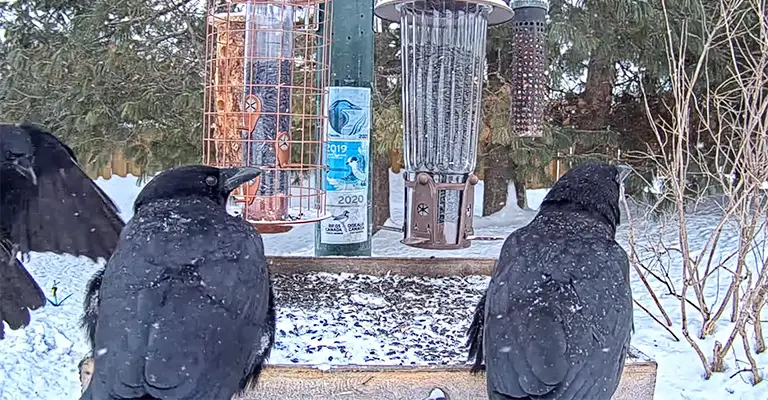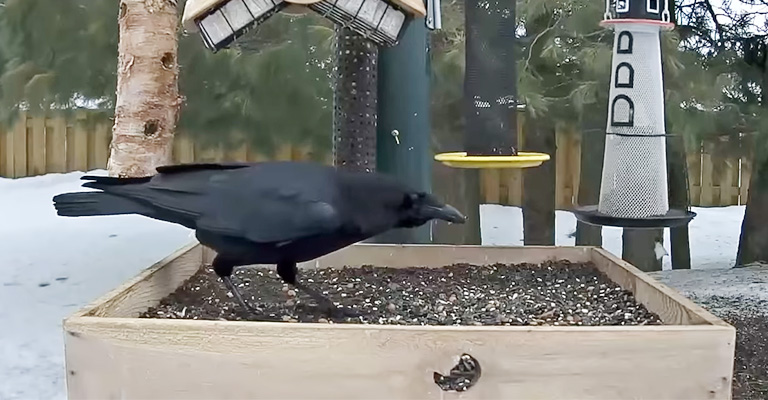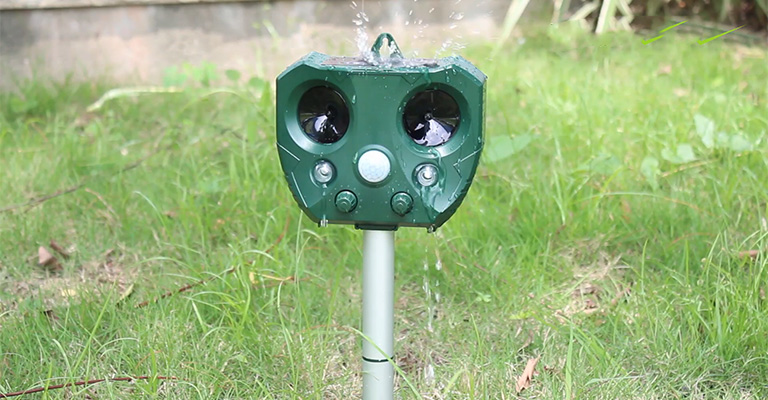Bird feeders are a wonderful way to attract a variety of beautiful birds to your yard, providing them with a reliable food source.
However, the presence of crows can sometimes pose a challenge, as they are known to be opportunistic feeders and may dominate the bird feeders, scaring away smaller birds.
If you’re looking to create a more welcoming environment for your feathered friends while deterring crows, this guide will provide you with effective strategies on how to keep crows away from bird feeders.
From simple adjustments to more advanced techniques, we’ll explore methods that are humane and environmentally friendly.
By implementing these measures, you can ensure that your bird feeders become a safe haven for the birds you wish to attract, allowing them to enjoy their meals undisturbed by crows.

How to Keep Crows Away from Bird Feeders?
To keep crows away from bird feeders, you can try the following strategies:
Use Physical Deterrents
Install a physical barrier around your bird feeder, such as a cage or mesh netting. Ensure that the openings are small enough to prevent crows from accessing the feeder while allowing smaller birds to pass through.
Modify the Feeding Area
Place the bird feeder in an open area away from trees or structures where crows can perch and access the food easily. Crows prefer perching on higher vantage points, so positioning the feeder in a more exposed location can discourage them.
Use Noise Deterrents
Crows are intelligent birds and can be deterred by loud noises. Hang wind chimes, aluminum foil strips, or other noise-making objects near the feeder. The unexpected sounds may startle the crows and discourage them from approaching.
Scarecrow or Decoy
Install a scarecrow or a decoy owl near the bird feeder. Crows are wary of predators, and the presence of these visual deterrents can make them think twice before approaching the area.
Remove Attractants
Crows are attracted to food sources, so it’s important to minimize any potential food waste or spills around the feeder. Regularly clean up fallen seeds or debris to reduce the incentive for crows to visit.
Change Feeding Times
Crows are diurnal birds, meaning they are most active during the day. Consider adjusting the feeding schedule for your bird feeder to early morning or late evening when crows are less likely to be around.
Use Alternative Feeders
Some bird feeders are designed to deter larger birds like crows while allowing smaller birds to access the food. Look for feeders with weight-sensitive perches or adjustable openings that can exclude larger birds.
Use Visual Deterrents
Crows are wary of shiny or reflective objects. Hang CDs, aluminum foil strips, or reflective tape near the bird feeder to create flashes of light that can deter them. You can also try hanging scare-eye balloons or old-fashioned scarecrow scare tape.
Employ Motion-activated Devices
Install motion-activated sprinklers or sound devices near the bird feeder. When crows approach, these devices will activate and startle them with bursts of water or loud noises, encouraging them to stay away.
Provide Alternative Food Sources
Crows are omnivorous and will eat a variety of foods. Consider setting up a separate feeding station away from the bird feeder specifically for crows. Offer them food like cracked corn, peanuts, or suet cakes to divert their attention from the bird feeder.
Use Natural Deterrents
Crows dislike certain scents and tastes. Sprinkle cayenne pepper, chili powder, or garlic powder around the bird feeder or mix it with the birdseed. The strong smell and taste may discourage crows from approaching.
Create a Physical Barrier
If crows are persistent, you can try enclosing the bird feeder in a wire cage with small openings that only allow smaller birds to access the food. This will prevent larger birds like crows from reaching the feeder.
Collaborate with Neighbors
If crows are a common problem in your area, consider discussing the issue with your neighbors. By implementing similar deterrent strategies in multiple yards, you can create a less attractive environment for crows and reduce their presence overall.
Remember, crows are intelligent and adaptable creatures, so it may take a combination of these strategies to effectively keep them away from your bird feeders.
Why Should You Get Rid of Crows?

While crows are intelligent and fascinating creatures, there are a few reasons why some people may want to deter them or limit their presence in certain areas:
Bird Feeder Competition
Crows are opportunistic feeders and can consume large quantities of birdseed, potentially depleting the food intended for smaller birds. This can discourage other bird species from visiting your feeders.
Nest Predation
Crows are known to prey on the eggs and nestlings of other bird species. If you have nesting birds in your yard, crows may pose a threat to their survival.
Crop Damage
In agricultural areas, crows can cause damage to crops, especially during planting and harvesting seasons. They may feed on seeds, fruits, and vegetables, leading to economic losses for farmers.
Noise and Nuisance
Crows are social birds and can be quite vocal, especially in large groups. Their loud cawing can be disruptive, particularly if they gather in large numbers near residential areas.
Safety Concerns
In some cases, crows can become aggressive, especially during their nesting season. They may dive-bomb or harass people or pets that come too close to their nests, potentially causing injuries.
It’s important to note that crows also provide ecological benefits, such as scavenging carrion, controlling insect populations, and aiding in seed dispersal.
Therefore, it’s generally recommended to find a balance that allows for coexistence with crows while minimizing any negative impacts they may have in specific situations.
How to Employ Motion-Activated Devices to Deter Crows?

To employ motion-activated devices to deter crows, follow these steps:
Choose the Right Device
There are various motion-activated devices available on the market, such as sprinklers, sound devices, and air blasters. Select a device that suits your needs and is designed to deter birds or larger pests like crows.
Install the Device
Follow the manufacturer’s instructions to properly install the motion-activated device near the area you want to protect, such as the bird feeder or garden.
Ensure that it is positioned in a way that covers the desired area and has a clear line of sight to detect motion.
Adjust the Settings
Most motion-activated devices have adjustable settings to control the sensitivity, range, and duration of the activation.
Set the device according to your specific requirements. For example, you may want it to activate only when crows come within a certain distance from the feeder.
Test the Device
Before relying on the device to deter crows, test it to ensure it is functioning correctly. Walk or move in front of the device’s sensor to trigger the activation and observe if it responds as expected.
Monitor and Adjust
Keep an eye on the device’s effectiveness in deterring crows. If you notice that crows are still approaching the area despite the device, you may need to adjust the settings or reposition the device to improve its coverage.
Maintain the Device
Regularly check the device to ensure it is in good working condition. Replace batteries if needed, clean any sensors or nozzles, and make any necessary adjustments to maintain its effectiveness.
Remember that motion-activated devices are just one tool in deterring crows. It’s often more effective to combine them with other strategies, such as physical barriers, noise deterrents, or alternative feeding options, to create a comprehensive approach to keep crows away from specific areas.
How to Make Use of an Ultrasonic Pest and Bird Repellent?

To make use of an ultrasonic pest and bird repellent, follow these steps:
Choose the Right Ultrasonic Repellent
Select a repellent device specifically designed to repel pests and birds using ultrasonic sound waves. Ensure that it has adjustable frequency settings and covers the desired range.
Read the Instructions
Carefully read and understand the manufacturer’s instructions before using the ultrasonic repellent. Familiarize yourself with the device’s features, settings, and any safety precautions.
Install the Device
Place the ultrasonic repellent in the area you want to protect, such as near bird feeders, gardens, or other areas where pests or birds are causing problems.
Follow the manufacturer’s instructions for proper installation, which may involve mounting it on a wall, stake, or other suitable surfaces.
Adjust the Frequency
Ultrasonic repellents emit high-frequency sound waves that are intended to be unpleasant for pests and birds. Adjust the frequency settings based on the specific pests or birds you want to repel. Different frequencies may be more effective against different species.
Power the Device
Connect the ultrasonic repellent to a power source, such as an electrical outlet or batteries, depending on the device’s requirements. Ensure that it is properly powered and functioning.
Monitor and Adjust
Keep an eye on the effectiveness of the ultrasonic repellent. Observe if pests or birds are being deterred from the area.
If you notice that the repellent is not having the desired effect, consider adjusting the frequency settings or repositioning the device for better coverage.
Maintain the Device
Regularly check the ultrasonic repellent to ensure it is in good working condition. Clean any sensors or speakers, replace batteries if needed, and make any necessary adjustments to maintain their effectiveness.
FAQs
Yes, crows can prey on the eggs and nestlings of other bird species, posing a threat to their survival. However, it’s important to handle them with precaution and care to protect the species.
Yes, crows can cause damage to crops, especially during planting and harvesting seasons, by feeding on seeds, fruits, and vegetables.
Motion-activated devices can be effective in deterring crows by startling them with bursts of water, loud noises, or other deterrent actions.
Yes, crows can become aggressive, especially during their nesting season, and may dive-bomb or harass people or pets that come too close to their nests.
Yes, crows provide ecological benefits such as scavenging carrion, controlling insect populations, and aiding in seed dispersal.
Final Words
With the strategies outlined in this guide, you can create a more peaceful and inviting environment for the birds visiting your feeders while deterring crows.
Remember to be patient and consistent in your efforts, as it may take some time for the crows to learn and adapt to the new deterrents.
Additionally, it’s important to prioritize the safety and well-being of all birds involved, ensuring that the methods used are humane and do not cause harm.
By striking a balance between providing food for the desired bird species and discouraging unwanted visitors, you can create a harmonious space where a diverse array of birds can thrive.
So, take action today and enjoy the beauty and serenity of your bird-filled yard, knowing that you have successfully kept crows at bay and protected your beloved feathered friends.